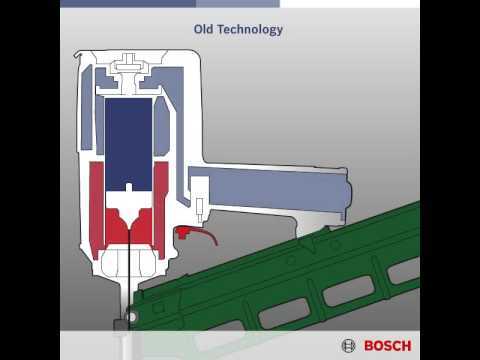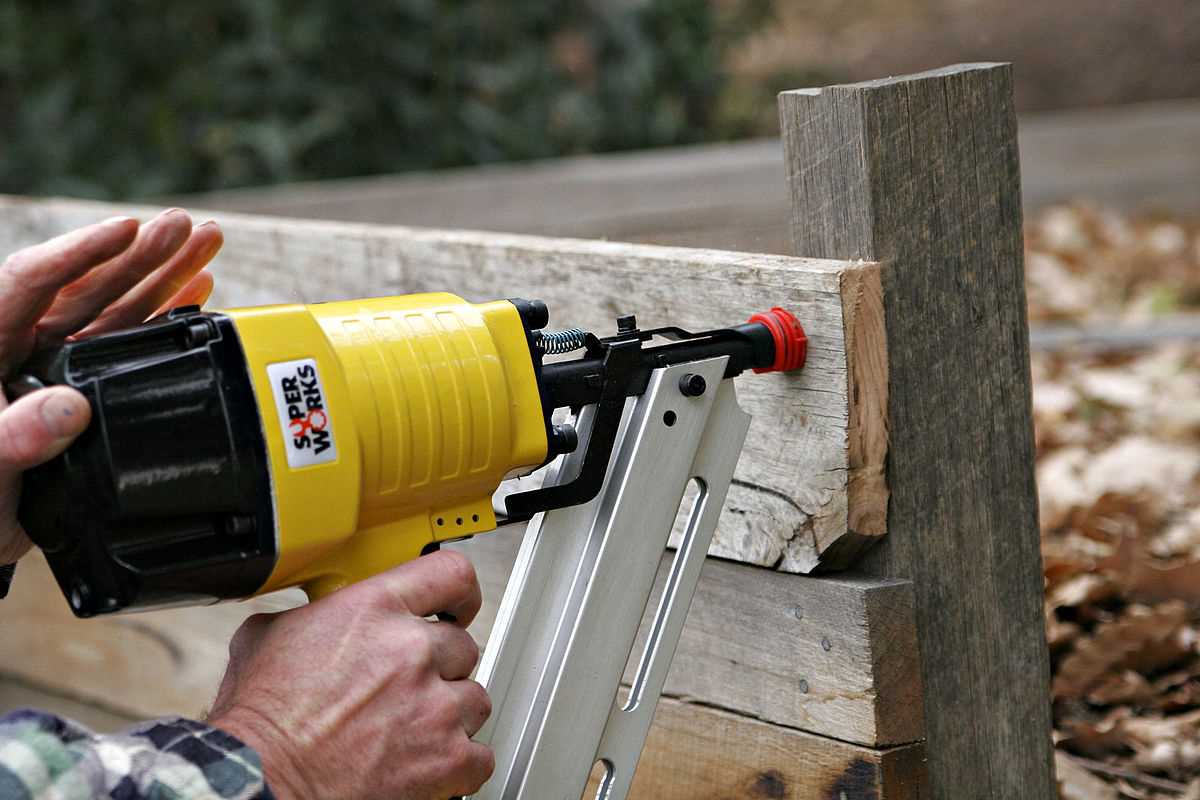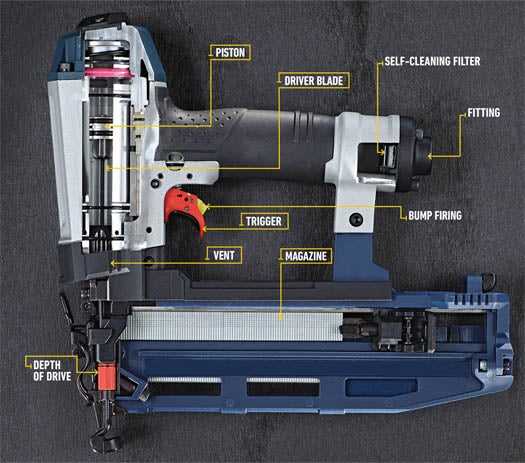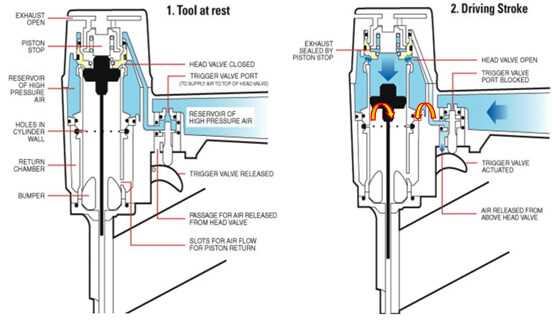How Does a Nail Gun Work: A Comprehensive Guide

When it comes to woodworking or construction, a nail gun is an essential tool that saves time and effort. But have you ever wondered how this powerful tool actually works? In this comprehensive guide, we will delve into the inner workings of a nail gun and explore the fascinating technology behind it.
A nail gun, also known as a nailer, is a handheld power tool that is designed to drive nails into various materials such as wood, metal, or concrete. Unlike traditional hammers, which require manual force to drive a nail into a surface, a nail gun uses compressed air, electricity, or combustion to deliver a high-speed and precise impact.
One of the key components of a nail gun is the magazine, where the nails are stored. The magazine is typically located at the bottom of the tool and can hold dozens of nails at a time. When the trigger is pulled, a nail is loaded into the barrel, ready to be fired.
Another important part of a nail gun is the piston or hammer mechanism. This mechanism is responsible for driving the nail forward with great force. The piston is powered by compressed air, an electric motor, or a small explosion in the case of a combustion-powered nail gun.
Overall, a nail gun is a powerful tool that combines precision, speed, and efficiency. Whether you are a professional carpenter or a DIY enthusiast, understanding how a nail gun works can help you make the most of this versatile tool.
The Basics of a Nail Gun
A nail gun is a power tool that is used to drive nails into different materials such as wood, metal, or concrete. It is a useful tool for construction, woodworking, and other related industries. Nail guns come in different types and sizes, but they all work on the same basic principles.
Types of Nail Guns

There are several types of nail guns available, each designed for specific purposes:
- Brad Nailers: These nail guns are used for smaller and more delicate projects. They are ideal for tasks such as trim work, crown molding, and furniture construction.
- Finish Nailers: These nail guns are used for larger projects. They are perfect for installing baseboards, door casings, and window trims.
- Framing Nailers: These nail guns are used for heavy-duty tasks such as framing houses, building decks, and installing subflooring.
- Roofing Nailers: These nail guns are specifically designed for attaching shingles to roofs. They are durable and can withstand the harsh conditions of roofing work.
- Concrete Nailers: These nail guns are used for attaching materials to concrete surfaces. They are commonly used in construction and remodeling projects.
How a Nail Gun Works

A nail gun makes the nailing process faster and more efficient compared to using a hammer and nails manually. The basic workings of a nail gun involve the following steps:
- Magazine Loading: Nails are loaded into the nail gun through a magazine. The magazine can hold a strip of nails or a coil, depending on the type of nail gun.
- Firing Mechanism: When the trigger of the nail gun is pulled, it activates the firing mechanism. The firing mechanism drives the nail forward and into the material being nailed.
- Air Pressure: Most nail guns are pneumatic and require compressed air to operate. Compressed air is stored in a small air tank within the nail gun. When the trigger is pulled, the compressed air is released, driving the nail into the material.
- Depth Adjustment: Some nail guns allow for adjustment of the depth at which the nail is driven into the material. This allows for precise control depending on the thickness of the material being nailed.
- Sequential Trigger: Many nail guns have a sequential trigger mechanism for safety. This means that the trigger must be pulled in a specific order for the nail gun to fire.
Uses of a Nail Gun
A nail gun has a wide range of uses in various industries and projects:
- Construction and framing
- Furniture and cabinet making
- Trim work and molding
- Roofing
- Decking
- Flooring installation
In summary, a nail gun is a versatile power tool that simplifies and speeds up the nailing process. It is available in different types for various applications and works by using compressed air to drive nails into materials.
Types of Nail Guns
There are several types of nail guns available, each designed for specific applications. The type of nail gun you choose will depend on your specific needs and the type of work you will be doing. Here are some of the most common types:
- Brad Nailer: This type of nail gun is best suited for delicate trim work such as attaching molding or baseboards. It uses small brad nails that are less likely to split the wood.
- Finish Nailer: A finish nailer is used for larger trim work and can handle thicker nails than a brad nailer. It is commonly used for attaching crown molding and casing.
- Framing Nailer: As the name suggests, a framing nailer is used for heavy-duty tasks such as framing walls or constructing decks. It can shoot large nails into tough materials like wood and steel.
- Roofing Nailer: This type of nail gun is specifically designed for roofing applications. It can quickly and securely attach shingles to roofs, making it an essential tool for roofers.
- Siding Nailer: A siding nailer is used for installing siding materials such as vinyl, aluminum, or fiber cement. It can handle longer nails and has a smaller nose to fit into tight spaces.
- Pin Nailer: A pin nailer is used for delicate and precise work, such as attaching thin or small pieces of wood or for crafts. It uses very thin pins that leave almost no visible holes.
In addition to these common types, there are also specialty nail guns available for specific tasks such as flooring, upholstery, and concrete. It’s important to choose the right type of nail gun for your project to ensure efficient and precise results.
Nail Gun Safety
Introduction
Using a nail gun can greatly increase productivity and make construction tasks easier. However, it is crucial to prioritize safety when operating a nail gun. This section will outline important safety measures to follow to minimize the risk of accidents and injuries.
Protective Equipment
Wearing the right protective equipment is essential when using a nail gun. This includes:
- Safety Glasses: Always wear safety glasses to protect your eyes from flying debris.
- Ear Protection: Nail guns produce loud noise, so wearing ear protection, such as earplugs or earmuffs, is recommended.
- Gloves: Use gloves to protect your hands from potential injuries or vibrations caused by the nail gun.
- Hard Hat: When working at heights or in areas where falling objects may pose a risk, wearing a hard hat is vital.
- Dust Mask: If working in dusty environments, consider wearing a dust mask to prevent inhaling harmful particles.
Proper Handling and Operation
Follow these guidelines to ensure safe handling and operation of a nail gun:
- Read the Manual: Familiarize yourself with the manufacturer’s instructions and safety guidelines outlined in the nail gun manual before use.
- Keep Your Finger Off the Trigger: Never place your finger on the trigger unless you are ready to fire. Keep your finger off the trigger when not in use to prevent accidental discharge.
- Keep the Gun Pointed Away from Yourself and Others: Always keep the nail gun pointed away from yourself and others to avoid accidental injuries.
- Confirm the Nail’s Path: Before nailing, ensure there are no obstructions or individuals in the nail’s path. Be aware of what is behind the material you are nailing into.
- Secure the Workpiece: Make sure the workpiece is properly secured or clamped to prevent movement while nailing.
- Never Carry a Loaded Nail Gun: Do not carry a nail gun with a loaded magazine or chamber, as it may accidentally fire.
- Avoid Bouncing or Recoil: Prevent the nail gun from bouncing or recoiling by maintaining proper contact with the workpiece. Do not apply excessive force.
- Disconnect Power Source: When not in use, disconnect the nail gun from the power source and remove any remaining nails to prevent unintentional activation.
Maintenance and Inspection
Maintaining and inspecting your nail gun on a regular basis is essential for safety. Here are a few key points:
- Clean the Gun: Regularly clean the nail gun to remove debris and prevent jamming.
- Inspect for Damage: Before each use, inspect the nail gun for any signs of damage or wear. If any issues are discovered, repair or replace the tool before using it.
- Use Proper Nails: Only use nails recommended by the manufacturer and ensure they are the appropriate size and type for the specific nail gun.
- Keep a Safe Distance: Maintain a safe distance from the tip of the nail gun while operating it to prevent accidental injuries.
- Store Properly: Store the nail gun in a secure, dry location, and always keep it out of reach of children.
Conclusion
By following these safety precautions, you can significantly reduce the risk of accidents and injuries while operating a nail gun. Remember, safety should always come first, regardless of the task at hand. Happy and safe nailing!
How Does a Nail Gun Work?
A nail gun is a powerful tool that is commonly used in construction and carpentry projects to quickly and efficiently drive nails into wood or other materials. Unlike hammering nails manually, which can be time-consuming and physically demanding, a nail gun makes the process much easier and faster.
Basics of a Nail Gun
A nail gun consists of the following basic components:
- Power source: Most nail guns are powered by compressed air, electricity, or gas. The power source provides the force needed to drive the nails into the material.
- Magazine: The magazine is where the nails are loaded and held. It typically has a capacity of anywhere from 30 to 100 nails.
- Trigger: The trigger is used to activate the nail gun and fire a nail. It is typically located on the handle of the nail gun and can be squeezed or pressed to activate the firing mechanism.
- Firing mechanism: The firing mechanism is responsible for driving the nail into the material. It can be a piston driven by compressed air or a electromagnet activated by electricity.
The Nail Firing Process
When the trigger is pressed, the nail gun goes through a series of steps to fire a nail:
- Nail loading: The operator loads nails into the magazine of the nail gun. The nails are typically held together with a strip or coil.
- Nail alignment: As the trigger is pressed, the firing mechanism aligns a single nail with the barrel of the nail gun. This ensures that the nail is positioned correctly for firing.
- Nail driving: When the firing mechanism is activated, it applies a force to the nail, propelling it forward into the material. The force can be provided by compressed air, an electromagnet, or other power sources depending on the type of nail gun.
- Nail setting: After the nail is driven into the material, it is countersunk or flush with the surface. This ensures a secure and professional finish.
Advantages of Using a Nail Gun
Using a nail gun offers several advantages over traditional hammering:
- Speed and efficiency: A nail gun can drive nails much faster than hammering, saving time and effort.
- Consistency: The firing mechanism of a nail gun ensures that each nail is driven with the same force and depth, resulting in a consistent finish.
- Reduced physical effort: Unlike hammering, which requires physical strength and endurance, a nail gun is powered and does most of the work for you.
- Versatility: Nail guns can accommodate different types and sizes of nails, allowing for greater flexibility in various applications.
Overall, a nail gun is a valuable tool for professionals and DIY enthusiasts alike. Its efficiency, speed, and ease of use make it an essential tool in any construction or carpentry project.
Benefits of Using a Nail Gun


1. Time-Saver
One of the biggest advantages of using a nail gun is its ability to save time. Compared to manual hammering, a nail gun can drive nails into materials much faster, allowing you to complete your projects more efficiently. This is especially beneficial for large-scale projects where hundreds or even thousands of nails need to be driven.
2. Increased Precision
Nail guns offer enhanced precision when it comes to driving nails. They allow you to control the depth at which the nail is driven, resulting in a more professional and clean finish. With a nail gun, you can ensure that every nail is driven to the desired depth, resulting in a more secure and sturdy construction.
3. Reduced Physical Strain

Using a hammer for extended periods of time can put a strain on your muscles and joints, leading to fatigue and potential injuries. Nail guns provide a more ergonomic solution, as they require less physical effort to operate. By reducing the strain on your body, nail guns allow you to work for longer periods of time without discomfort or fatigue.
4. Versatility
Nail guns come in various types and sizes, each designed for specific applications. Whether you need to drive nails into wood, concrete, or metal, there is a nail gun available for the job. This versatility allows you to tackle a wide range of projects with a single tool, making it a cost-effective and efficient choice.
5. Improved Safety
Nail guns are designed with safety features to minimize the risk of accidental firing. They often require a two-step activation process, such as pressing the nose of the gun against the material before pulling the trigger. These safety mechanisms help prevent accidental injuries and make nail guns a safer option compared to traditional hammers.
6. Increased Productivity
With the speed and efficiency provided by nail guns, you can significantly increase your productivity. The time saved from using a nail gun allows you to take on more projects or complete existing projects faster. This can lead to increased profitability for professionals and a more satisfying DIY experience for hobbyists.
7. Professional Results
By using a nail gun, you can achieve professional-level results in your woodworking or construction projects. The precision, speed, and consistency offered by nail guns contribute to a higher quality finish. Whether you are a professional contractor or a DIY enthusiast, using a nail gun can help elevate the overall appearance and durability of your work.
8. Cost-Efficient
While nail guns may require an initial investment, they can save you money in the long run. By increasing your productivity, reducing material waste, and minimizing the need for repairs, nail guns can help lower overall project costs. Additionally, the versatility of nail guns makes them a versatile tool that can be used for multiple projects, providing further cost savings.
Common Uses for Nail Guns
1. Construction and Framing
Nail guns are commonly used in the construction industry for framing tasks. They are used to secure wooden boards together, such as walls, floors, and ceilings. Nail guns can quickly and efficiently drive nails into the wood, making the framing process much faster than using a hammer and nails manually.
2. Trim Work
Nail guns are also frequently used for trim work, such as installing baseboards, crown molding, and window or door casings. These tasks require precise and accurate nailing, which can be easily accomplished with the use of a nail gun.
3. Roofing
Roofing is another area where nail guns are indispensable. They are used to secure shingles or other roofing materials onto the roof deck. The speed and accuracy of nail guns make roofing jobs more efficient and reduce the risk of injury associated with manual nailing.
4. Upholstery
Nail guns are also used in upholstery work. They can quickly attach fabric or leather to furniture frames, providing a secure and professional finish. Upholstery nail guns are specially designed to be gentle on delicate materials while still providing enough power to secure the fabric.
5. Woodworking Projects
Nail guns are commonly used in woodworking projects, such as building furniture or constructing cabinets. They can quickly and easily attach pieces of wood together, making the process of building furniture or other wooden structures much more efficient.
6. Subfloor Installation
When installing subflooring, nail guns are used to secure plywood or other subfloor materials to the floor joists. This ensures that the subfloor is securely fastened and provides a stable base for the finished flooring.
7. Fence Construction
Nail guns are often used in fence construction to quickly and securely attach fence boards to the posts and rails. This saves time and ensures a sturdy fence that can withstand the elements.
8. DIY Projects
Aside from professional applications, nail guns are also commonly used in various DIY projects. From building a bookshelf to constructing a deck, nail guns can make the process faster and easier for homeowners.
9. Crafts and Art Projects
Nail guns can even be used for crafts and art projects. They can be used to attach pieces of wood or other materials together to create unique sculptures or art installations.
10. Fastening Upholstery Materials
In addition to furniture upholstery, nail guns can be used to fasten upholstery materials to other surfaces, such as attaching fabric to bulletin boards or other decorative projects.
In conclusion, nail guns have a wide range of uses in various industries and DIY projects. They provide a faster, more efficient, and precise way to secure materials together compared to traditional hammer and nails methods.
Troubleshooting Nail Gun Issues
If you’re experiencing problems with your nail gun, there are a few common issues you can check for and troubleshooting steps you can take to resolve them. Here are some tips to help you identify and fix common nail gun problems:
1. Jammed Nail
If your nail gun is not firing nails or is only firing intermittently, there may be a jammed nail blocking the nail channel. To fix this issue, follow these steps:
- Disconnect the nail gun from the power source or remove the battery.
- Open the nail magazine or nail channel cover.
- Inspect the area for any stuck nails or debris.
- Use a pair of needle-nose pliers or a nail punch tool to remove the jammed nail.
- Clean the nail channel and remove any dirt or debris.
- Close the nail magazine or nail channel cover and reconnect the power source or insert the battery.
2. Misfiring
If your nail gun is misfiring or shooting nails inconsistently, there may be a problem with the firing mechanism. Follow these steps to troubleshoot the issue:
- Check the air pressure or battery charge level. Low air pressure or a weak battery can result in misfiring.
- Inspect the nosepiece for any obstructions or debris that may be interfering with the firing mechanism.
- Clean the nosepiece and remove any dirt or debris.
- Examine the driver blade for any signs of damage or wear. A worn-out driver blade may need to be replaced.
- Ensure that the nails being used are the correct size and type for your nail gun.
3. Air Leak
If you notice a constant hissing sound or air leakage from your nail gun, there may be a problem with the compressed air system. Follow these steps to troubleshoot an air leak:
- Inspect the air hose, fittings, and connections for any visible damage or loose connections.
- Tighten any loose fittings or connections using a wrench or pliers.
- Apply thread sealant to the air hose fittings to ensure a proper seal.
- Check the O-rings and seals inside the nail gun for any signs of wear or damage. Replace them if necessary.
- If the air leak persists, it may be a more significant issue that requires professional repair.
4. Weak or No Power
If your nail gun is not driving nails all the way or lacks power, there may be an issue with the compressor or power source. Follow these steps to troubleshoot power problems:
- Check the air pressure or battery charge level. Low pressure or a weak battery can result in a weak nail-driving power.
- Clean and lubricate the compressor or motor according to the manufacturer’s instructions.
- Inspect the compressor or battery for any signs of damage or wear. Replace them if necessary.
- Ensure that the nail gun is properly connected to the power source or the battery is securely in place.
- If the power issue persists, it may be a more significant problem that requires professional inspection and repair.
5. Safety Precautions
Always remember to follow safety precautions when troubleshooting nail gun issues:
- Wear appropriate safety gear, including safety glasses and hearing protection.
- Disconnect the power source or remove the battery before performing any troubleshooting or maintenance.
- Refer to the manufacturer’s instructions and guidelines for your specific nail gun model.
- If you are unsure about any aspect of troubleshooting or repair, consult a professional or contact the manufacturer for assistance.
By following these troubleshooting steps and safety precautions, you should be able to diagnose and fix common issues with your nail gun, ensuring optimal performance and safety.
FAQ
What is a nail gun?
A nail gun is a power tool that is used to drive nails into various materials, such as wood or concrete, at a rapid speed and with precision.
How does a nail gun work?
A nail gun works by using compressed air, electromagnetism, or a small explosive charge to drive the nail into the material. It typically has a magazine to hold the nails and a trigger to activate the firing mechanism.
What are the types of nail guns?
There are several types of nail guns, including pneumatic nail guns, electric nail guns, and gas-powered nail guns. Each type has its own advantages and is suitable for different applications.
How does a pneumatic nail gun work?
A pneumatic nail gun works by using compressed air to create a high pressure that drives the nail into the material. When the trigger is pulled, the compressed air is released, pushing the piston forward and driving the nail out of the gun.
What are the advantages of using a nail gun?
Using a nail gun has several advantages, including increased speed and efficiency, improved precision, reduced fatigue, and less damage to the material compared to traditional hammering.
Is it safe to use a nail gun?
When used properly, a nail gun can be safe to use. However, it is important to follow the manufacturer’s instructions, wear appropriate safety gear, and take precautions to prevent accidental firing or injuries.
What are some tips for using a nail gun?
Some tips for using a nail gun include practicing on scrap materials before beginning a project, holding the nail gun firmly and at the right angle, keeping your hands and fingers away from the firing area, and regularly inspecting and maintaining the tool.
Video









